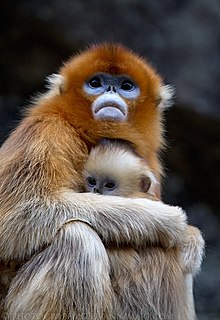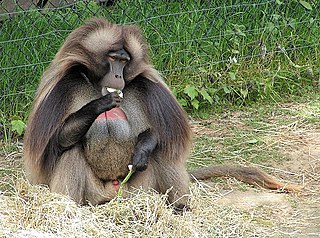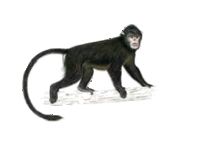
Old World monkey is the common English name for a family of primates known taxonomically as the Cercopithecidae. Twenty-four genera and 138 species are recognized, making it the largest primate family. Old World monkey genera include baboons, red colobus and macaques. Common names for other Old World monkeys include the talapoin, guenon, colobus, douc, vervet, gelada, mangabey, langur, mandrill, surili (Presbytis), patas, and proboscis monkey. Phylogenetically, they are more closely related to apes than to New World monkeys. They diverged from a common ancestor of New World monkeys around 45 to 55 million years ago.

Snub-nosed monkeys are a group of Old World monkeys and make up the entirety of the genus Rhinopithecus. The genus is rare and not fully researched. Some taxonomists group snub-nosed monkeys together with the genus Pygathrix.

Fauna & Flora International (FFI) is an international conservation charity and non-governmental organization dedicated to protecting the planet's threatened wildlife and habitats. Founded in 1903, it is the world's oldest international conservation organisation. The logo of the society is the Arabian oryx, after the successful Operation Oryx, a flagship captive breeding and reintroduction project undertaken by the society.

The black-and-white snub-nosed monkey, also known as the Yunnan snub-nosed monkey, is a large black and white primate that lives only in the southern Chinese province of Yunnan, where it is known to the locals as the Yunnan golden hair monkey (滇金丝猴) and the black-and-white snub-nosed monkey (黑白仰鼻猴). The common name, black snub-nosed monkey, is issued to Rhinopithecus strykeri, inhabiting the Northern Sino-Myanmar border. Coniferous and deciduous forests in the mountainous regions of Yunnan are the ideal terrain for these primates. It is threatened by habitat loss, and is considered an endangered species. With their unique adaptations to their environment, these monkeys thrive at extreme altitudes despite the below freezing temperatures and thin air. This primate's diet is mainly made up of the large amounts of lichens available in their region.

The gray snub-nosed monkey, also known as Brelich's snub-nosed monkey, Guizhou snub-nosed monkey, and Guizhou golden monkey, is a species of primate in the family Cercopithecidae. It is endemic to China, where it is known as the Guizhou golden hair monkey (黔金丝猴) or gray golden hair monkey (灰金丝猴). It is threatened by habitat loss. Of the three species of snub-nosed monkeys in China, the gray snub-nosed monkey is the most threatened, with a total population thought to number fewer than 400 individuals.

The golden snub-nosed monkey is an Old World monkey in the subfamily Colobinae. It is endemic to a small area in temperate, mountainous forests of central and Southwest China. They inhabit these mountainous forests of Southwestern China at elevations of 1,500–3,400 m (4,900–11,200 ft) above sea level. The Chinese name is Sichuan golden hair monkey (四川金丝猴). It is also widely referred to as the Sichuan snub-nosed monkey. Of the three species of snub-nosed monkeys in China, the golden snub-nosed monkey is the most widely distributed throughout China.

Critical Ecosystem Partnership Fund (CEPF) is a joint biodiversity conservation initiative of l'Agence Française de Développement, Conservation International, European Union, Global Environment Facility, Government of Japan, and World Bank. CEPF also receives funding from several regional donors, including the MAVA Foundation, Margaret A. Cargill Philanthropies, and The Leona M. and Harry B. Helmsley Charitable Trust. The fund’s headquarters are hosted at Conservation International in Arlington, Virginia, United States.

The Tonkin snub-nosed monkey or Dollman's snub-nosed monkey is a slender-bodied arboreal Old World monkey, endemic to northern Vietnam. It has black and white fur, a pink nose and lips, and blue patches around the eyes. It is found at elevations from 200 to 1,200 m on fragmentary patches of forest on craggy limestone areas. First described in 1912, the monkey was rediscovered in 1990 but is exceedingly rare. In 2008, fewer than 250 individuals were thought to exist, and the species was the subject of intense conservation effort. The main threats faced by these monkeys are habitat loss and hunting, and the International Union for Conservation of Nature has rated the species as "critically endangered".

One-male groups are a type of social organization where one male interacts with a group of females and their immature offspring. Offspring of both sexes are evicted from the group upon reaching puberty. It can be seen in many species of primates, including the gelada baboon, the patas monkey, savanna baboon, sun-tailed monkey, golden snub-nosed monkey, and the hamadryas baboon. There are costs and benefits for individuals living in one-male groups. As well, individuals within one-male groups can interact with each other just like individuals can interact with those from different one-male groups.

The Myanmar snub-nosed monkey or Burmese snub-nosed monkey or black snub-nosed monkey is a critically endangered species of colobine monkey discovered in 2010 in northern Burma (Myanmar). It was formally described as a novel species of primate in 2011 based on its fur, beard and tail. Two groups of the species were discovered in China in 2011 and 2015, respectively.
Jon Lloyd Stryker is an American architect, philanthropist, and billionaire heir to the Stryker Corporation medical technology company fortune.

Biodiversity and Nature Conservation Association (BANCA) is a Burmese non-governmental organisation established in the capital city Yangon. The society aims to conserve natural diversity and promote awareness. It remains the leading force in Burma for biodiversity conservation and sustainable development.
The Gaoligongshan National Nature Reserve (GNNR) is a protected area comprising the Gaoligong Mountains and the nearby Nu Jiang Reserve in the western Yunnan Province of China, near the international boundary of Burma. It covers a vast stretch of the junction of Baoshan City, Tengchong and Lushui County, towards the west side of Nu (Salween) River.
Kashmira Kakati is a wildlife biologist and environmental activist working the North Eastern forests of India. In 2010, she announced the discovery of the presence of seven species of wild cats in the Jeypore-Dehing forests in Assam. Her work using camera traps to find wild cats was featured in the first episode of the BBC documentary Lost Land of the Tiger (2010).
Prunus obtusata is a species of bird cherry native to Tibet, southern China and Taiwan, preferring to grow at 800–3600 m. It is a tree typically 6–20 m tall. Its flowers are borne on a raceme, with white petals. The fruit is black.











